Problem Soils: Managing Saline Soils
[addw2p name=”problemSoils”]
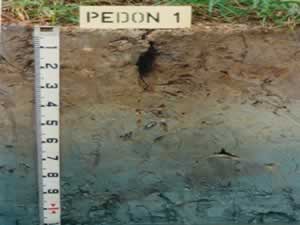
Kranji
Saline soils occur by the sea or around river mouths and are constantly inundated by sea or brackish water. Consequently, they have a young A/C profile with conductivity commonly above 10,000 µmhos cm-1. In potential acid sulfate soils such as Bakau series, may contain high water soluble sulfate exceeding 0.35%. Saline soils generally occur in low rainfall region in Malaysia.
Our plantation tree crops are not salt tolerant and hence cannot be grown on saline soils before ameliorations. Despite this, a number of large plantation companies in Malaysia, such as K.L. Kepong Bhd., Sime Darby Bhd. and Golden Hope Plantation Bhd., have successfully grown oil palms on it. However, before reclamation work proceeds, we have to ensure that at least the following conditions prevail at the site.
- materials for bunding are available,
- if (a) is unavailable, then the “n” value of the soils should be less than 0.7
- most of the land boundary should not be erosional surface,
- the land should preferably be higher than the sea or river level at low tides,
- rainfalls should be sufficient (> 1700 mm yr-1) to allow flushing and leaching of salts,
- land area must be sufficiently large to dilute the cost of reclamation and maintenance to economic level
Preventing further intrusion of sea or brackish water of more than 1000 µmhos cm-1 into the land is central to reclamation of saline soils. This is accomplished by construction a band around the periphery of the land. The bund should be at least 3 feet above the highest tide level.
Consideration must be given to the river and its tributaries in the land in deciding the course of the bund.
Upon completion of bund construction, a drainage network comprising main and collection drains must be laid down to reduce the water table and allow for subsequent flushing of the drains. There must be sufficient watergates and water pumps to remove the water trapped in the land. The periodic flushings usually continue for two to four years before the conductivity drops below 2000 µmhos cm-1 within the top 45 cm to allow successful planting of oil palms.
Once the above is achieved, field drains are then constructed to lower the water table to between 50 to 70 cm from the soil surface. Planting of oil palms and other cultural practices resemble those of coastal soils. However, boron application is generally unnecessary.
Bund maintenance to prevent seepage and leakage and sound water management are necessary to ensure successful reclamation of saline soils for oil palms. An example of yield profile of oil palms on saline soils with mean annual rainfalls of 18.22 mm is shown in Figure 5. The mean FFB yields were low due to two periods of distinct dry season per year although occasionally they may exceed 24 t ha-1 yr-1.
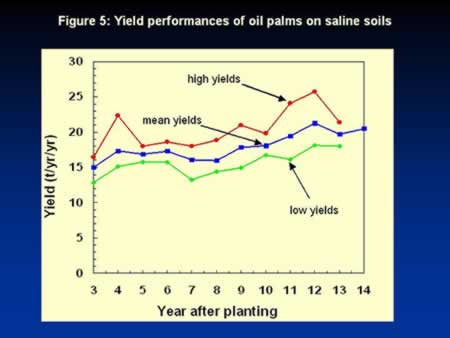
Problem Soils: Managing Shallow Acid Sulfate Soils
[addw2p name=”problemSoils”]
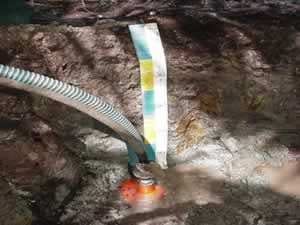
Sedu
Acid sulfate soils are estimated to cover an area of about 110,000 ha in Peninsular Malaysia with at least 20,000 ha under oil palms (Poon and Bloomfield, 1977). These soils are characterised by very low pH values (< 3.5) and the presence of yellowish jarosite (Kfe3 (So4)2 (OH)6) mottles (Shamshuddin and Auxtero, 1991).
The problems with acid sulfate soils are:-
- they tend to be waterlogged in their natural state and must be drained before cultivation, and
- draining beyond the pyrite layer will generate excessive acidity which is detrimental to palm growth.
The latter is due to the oxidation of pysite to form sulphuric acid as shown below:

This oxidation also causes breakdown of clay minerals which releases Al, Mn and K into the soil solutions (Shamshuddin and Auxtero, 1991). The drop in pH to below 3.0 is not uncommon and the oil palms will suffer hyperacidity symptoms and poor yields Toh and Poon (1982) further, classified acid sulfate soils into 3 categories based on oil palm performances. Their severe category has acid layer at 0 to 60 cm while current soil classification in Malaysia tag it at 0 to 50 cm for shallow acid sulfate soils, such as Linau and Sedu series.
Hew and Khoo (1970) found that liming was generally ineffective to control acidity in acid sulfate soils. Poon and Bloomfield (1977) then showed that by creating anaerobic conditions, the reaction in equation (1) will not proceed and thus, preventing the generation of acidity. Since inadequate drainage will give rise to flooded conditions which also adversely affect palm performance, a balance has to be struck between over and under drainage.
This balance is achieved through a network of field, collection and main drains similar to those found in peat swamp as described earlier but their objective differs. The prime requirement in the management of acid sulfate soils is that the water-table should be maintained above the pepsitic layer for as long as possible. This is again carried out using stops, weirs and watergates, their numbers are largely determined by the depth to pysiritic layer and slope of the land. Normally, the water-table is maintained between 45 to 60 cm from the soil surface, hence, the depth of field drains should not exceed 75 cm. Otherwise, there is a risk of accelerated oxidation of the pyritic layer during dry weather conditions (Poon, 1983).
Another important aspect in the management of shallow acid sulfate soils is to provide for periodic flushing of the drains to remove the accumulated toxic polyvalent ions such as Al3+ and the extremely acidic water (Poon, 1983). Therefore, during the wet season, all the water retention blocks and watergates are opened to allow flushing. One to two flushing during the wet season are usually adequate. Before the end of the wet season, the blocks and watergates are again closed to allow fresh water to build up to the required level.
The other aspects of management of acid sulfate soils are similar to those of coastal non-acid sulfate soils. The success in using water control to manage oil palms on shallow acid sulfate soils is best illustrated by Figure 4.
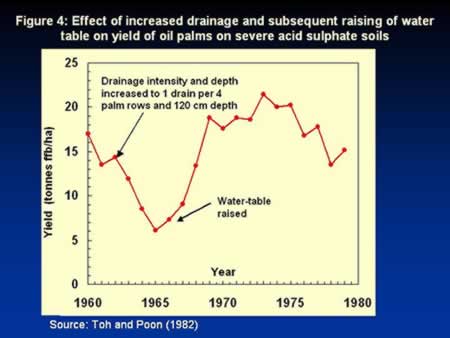
Problem Soils: Managing Deep Peat
[addw2p name=”problemSoils”]

Gondang
There are 2.4 million hectares of peat in Malaysia, with 1.5 million hectares occurring in Sarawak alone. Oil palms are cultivated on peat on a large scale since the mid fifties. However, major problems were encountered especially on deep peat and it was not until the eighties that oil palms are successful grown on it.
The problems with deep peat lie in its physical and chemical characteristics. Peat, in its natural state, contains excessive amount of water due to its low physiography and water holding capacity of 20 to 30 times its own weight. Consequently, aeration is poor and bulk density is very low at less than 0.1 g cm-3. Upon drainage, peat will undergo irreversible drying and extensive subsidence of 3.6 cm yr-1. Apart from this, peat provides an imbalance nutritional medium for plant growth (Table 1). Although it has high total N content, it also has high C:N ratio, rendering a slow availability of N to the plant. Moreover, it has low K, Cu, Zn and B and high acidity of pH less than 4.0 (Gourmit et al., 1987).
| Chemical analysis |
Units |
Values for samples from 0-45 cm depth |
| Soil reaction |
pH |
3.5 |
| Moisture content (d.w.b.) |
% |
347 |
| Loss on ignition |
% |
90.4 |
| Total C |
% |
56.5 |
| Total N |
% |
1.40 |
| C/N ratio |
– |
39.9 |
| Mineral N |
ppm |
98 |
| Mineral N |
% of total N |
0.71 |
| Total P |
% |
0.056 |
| Total K |
% |
0.026 |
| Total Ca |
% |
0.125 |
| Total Mg |
% |
0.129 |
| Cation exchange capacity |
m.e.% |
145.0 |
| Exchangeable H |
m.e.% |
134.0 |
| Exchangeable K |
m.e.% |
0.28 |
| Exchangeable Ca |
m.e.% |
7.4 |
| Exchangeable Mg |
m.e.% |
1.7 |
| Base saturation |
% |
7.9 |
| Total Mn |
ppm |
25 |
| Total Fe |
ppm |
3446 |
Bearing this in mind, United Plantations Berhad (UPB) has developed various novel methods to alleviate the problems and allow successful cultivation of oil palms on deep peat. Therefore, this part of the lecture note is extensively drawn from a paper written by Gurmit et al. (1987).
The first problem confronting a developer is to remove the excessive water in the peat swamp before felling and clearing operation can be initiated. This is done by constructing a perimeter drain, the dimensions of which depend on the size of area to be cleared and distance from a river outlet, using an excavator. Due consideration should be given out to overdrain the area as this will result in rapid shrinkage of the peat and irreversible drying of the top layer, which adversely affects establishment and growth of oil palms.
Basically, the drainage system consists of a network of field, collection and main drains (Figure 1), the dimensions of which are:
| Type of drain |
Width (cm) |
Depth (m) |
|
|
Top |
Bottom |
||
| Field |
1.0 – 1.2 |
0.5 – 0.6 |
0.9 – 1.0 |
| Collection |
1.8 – 2.5 |
0.6 – 0.9 |
1.2 – 1.8 |
| Main |
3.0 – 6.0 |
1.2 – 1.8 |
1.8 – 2.5 |

The intensity of drains depends on the topography of the field and planting density but the primary objectives is to keep the water levels at 50 to 75 cm from the surface at most times. This is achieved through a series of stops, weirs and watergates. Periodic flushing of the acidic and excessive storm water during the rainy season is also carried out.
The low bulk density and subsidence earlier present obstacles to road construction and planting. Field and main roads are now created using spoils from roadside drains, levelled and compacted by bulldozer and then lined with laterite and mining ballasts. Before planting, the harvesting path and planting rows are mechanically consolidated by running an excavator 2 to 3 times over them. The completed operation leaves a 9.5 to 3 times over them. The completed operation leaves a 9.5 to 11.5 m wide area free of timber and compacted to a depth of 40 to 50 cm (Figure 2). Consolidation increases the bulk density from 0.11 to 0.20 g cm-3, reduces the incidences of leaning and fallen palms by half and improves FFB yield by 25%. Planting density is also increased to 160 palms ha-1 to attain optimum leaf area index of 6.0 for production by the 10th year on this poor growing medium.

The irreversible drying of the top layer is prevented by maintaining satisfactory water-level of 50 to 70 cm from surface, and good ground vegetation of light grasses and low density of Nephrolepis biserrata . Moreover, blanket spraying may increase the risk of fire and affect the predator-pest balance.
Deep acid peat provides an interesting nutritional complexes to agronomists. While total N content can be high (1.3 to 1.5%), its availability is low due to high C:N ratio (Table 1). Upon drainage (Table 2), liming and decline in C:N ratio and higher N availability. Thus the priority is to provide high N rate (up to 1.2 kg urea palm-1 yr-1) in the initial immature phase and subsequently reduce it during the mature phase (0.5 to 1.25 kg urea palm-1 yr-1). This approach was supported by the work of Gurmit et al. (1987) which showed good FFB response to N in the first 4 years of harvests only (Table 3).
| Items |
pH (H20) |
Exc. Acidity |
C.E.C. at pH |
Ash |
Total Analysis |
C |
N |
C/N |
||||||
|
H |
A1 |
3.9 |
7.0 |
8.2 |
Ca |
Mg |
K |
P |
||||||
|
cmol (+) kg |
% (w/w) |
|||||||||||||
| Undrained |
4.0 |
17.1 |
4.5 |
26.4 |
118.7 |
161.8 |
5.0 |
0.05 |
0.02 |
0.01 |
0.059 |
35.4 |
0.98 |
36 |
| Drained |
3.8 |
20.9 |
4.2 |
33.2 |
139.0 |
160.1 |
5.6 |
0.11 |
0.04 |
0.02 |
0.051 |
28.1 |
1.41 |
20 |
| Fibric |
4.2 |
16.4 |
4.7 |
26.0 |
110.0 |
152.9 |
4.3 |
0.05 |
0.02 |
0.01 |
0.058 |
34.4 |
0.80 |
43 |
| Hemic |
4.0 |
22.0 |
3.3 |
32.9 |
134.0 |
162.6 |
3.1 |
0.09 |
0.04 |
0.01 |
0.061 |
28.8 |
0.88 |
33 |
| Sapric |
3.6 |
19.7 |
4.7 |
32.3 |
145.3 |
169.9 |
9.2 |
0.12 |
0.06 |
0.02 |
0.064 |
25.6 |
1.65 |
17 |
| Treatment |
FFB yield (kg/palm) |
|||
|
Mean of 1st 3 years |
4th year |
5th year |
6th year |
|
| N1 |
148 |
152 |
174 |
199 |
| N2 |
161 |
163 |
184 |
205 |
| Var. Test |
6.9* |
6.8* |
ns |
ns |
| % Increase |
8.8 |
7.2 |
5.7 |
3.0 |
The mineralisation of peat also releases P to the system, which contains low Al and Fe for fixation. Therefore, only low P rates of 0.5 to 1.0 kg phosphate rock palm-1 yr-1 are generally provided. Excessive P application can leads to lower yield and Cu imbalance (Cheong and Ng, 1977). On the other hand, potassium is very deficient in peat and hence, high rate of muriate of potash up to 5.0 kg palm-1 yr-1 is recommended (Gurmit et al., 1987).
Although good response to liming has been obtained the effect is unlikely to be due to Ca. It is most probably a result of improved mineralisation rate, increased soil pH and a better cationic-anionic balance in the plant system (Cheong and Ng, 1980).
Peat is also deficient in Cu, Zn and B. Early dressings with these micronutrients are essential to avoid mid-crown chlorosis, peat yellow and stump leaves respectively. However, excessive B application must be avoided as it can be phytotoxic and adversely affect the uptake of Cu (Gurmit et al., 1987).
Draining the peat swamp increases acidity as shown in Table 2. This is alleviated by periodic flushing of the drain water, especially during rainstorms, and liming. Maintenance of correct water levels is also important since hyperacidity seems to occur only during prolonged dry spell.
Proper soil and water management of oil palms on deep peat has resulted in FFB production closely mirroring that on good mineral soils (Figure 3). However, we must caution that the problems with planting oil palms on deep peat escalated exponentially with the areas of peat, particularly in relation to the amount of good mineral soils in the plantation.

Soil Management: Problem Soils
[addw2p name=”problemSoils”]
Introduction
The first part of this paper elucidates general the principles of soil management, soil requirements and proper soil management practices for plantation tree crops. We shall now discuss how we can combine them interactively to manage problem soils for tree crops.
The term “problem soils” appeared many times in literature but it has not been well-defined yet. Longman dictionary describe the word “problem” as “a difficulty that needs attention and thought”. Therefore, problem soils may be defined as soils which require special or specific attention, though and methods to successfully managed them. Within the plantation industry, the conceptional idea of problem soils is probably “unsuitable soils for cultivation in their natural states but upon proper soil management and amendments, they can be converted for plantation tree crops with yield performances, at times, matching those on suitable soils”.
Based on this concept, there are probably six groups of problem soils, namely,
- deep peat
- shallow acid sulfate soils
- saline soils
- shallow lateritic soils
- podzols or spodosols, and
- sandy soils (quartzipsamments)
Each group of soils requires its own specific soil management practices and crop species. With the present lack of labour, cost of management and price of produce, oil palm is the primary tree crop grown on these soils. Therefore, this paper will be confined to practices pertaining to oil palm only while another lecture will present their characteristics and management for other crops.
There is a growing and discernible pressure from some quarters to utilise problem soils for oil palms despite the much more effort, time, difficulty and cost to do so which reduces competitiveness. This might stem from the reports of high yields on these soils but more so, from the lack of large scale experience to manage them for oil palms or for political gains. Our own experiences generally indicate that it is probably inadvisable to have more than a quarter of problem soils in any one plantations for long-term viability. Nevertheless, it is still critical to manage these soils correctly from economic standpoint, environmental consideration and to maintain competitiveness.
Reference
Goh, K.J. and Chew, P.S. (1995). Managing soils for plantation tree crops. II. Managing Problem Soils in Malaysia. In: Course on Soil Survey and Managing Tropical Soils (ed. Paramanathan, S.). MSSS and PASS, Kuala Lumpur: 246-256.
Note: The full list of references quoted in this article is available from the above paper.
Soil Management: Conclusions
[addw2p name=”soilMgmtGeneral”]
Cultivation of plantation tree crops is still expanding rapidly in south-east Asia, particularly in Malaysia and Indonesia. A diversified range of soils is used with increasing proportion of marginal soils. It is vital that good soil management is implemented to ensure high sustainable production for economic viability and maintain or improve soil fertility. There is also a growing concern on soil degradation and environmental pollution with high inputs agriculture but these can be avoided with good soil management.
The first approach in soil management is to identify the soil constraints to crop production and assess their degree of severity. In the humid tropics, these detriments are closely related to nutrients and water which are the most limiting factors to crop productivity. Both are available via the soil to the plants, particularly those with good rooting activity.
The rooting activity of plants are influenced by many soil properties such as terrain, texture, structure, consistency, permeability, drainage and inherent nutrients. They require interactive management approach to achieve the basic objectives of crop productivity and maintenance of soil fertility and to do so in an environmentally acceptable way. These soil management approaches encompass soil and water conservation management, soil fertility management, soil acidity management and soil water management.
The concepts of good soil management is nothing new and best exemplified by the following quotation from Sanskrit, the classical, literary language developed from about 1500 B.C. by the Hindus in Northern India (Johnson, 1995).
“Upon this handful of soil our survival depends. Husband it and it will grow our food, our fuel and our shelter and surround us with beauty. Abuse it and the soil will collapse and die taking man with it”.
This adage which has evolved through time, still poignantly encapsulates a major concern today; so when will man learn to ensure plentiful food and beauty for the generations to come, if it is not now.
Soil Management: Soil Water Management
[addw2p name=”soilMgmtGeneral”]
Water management practices include drainage and irrigation of the land, and soil moisture conservation practices. Adequate soil moisture is required for good growth and yield of plantation tree crops. Hence, good responses to irrigation have been reported (Hutcheon et al ., 1973; Kee and Chew 1993, Lim et al ., 1994). However, excessive water such as high water table can reduce crop productivity substantially (Lim et al ., 1994).
Soil moisture conservation measures or irrigation will be beneficial in the following areas :
- inadequate rainfall of less than 1700 mm per year,
- poor rainfall distribution pattern,
- somewhat excessively to excessively drained soils,
- very shallow soil or soil causing restricted rooting.
As irrigation is frequently impossible due to inavailability of water and high capital costs of installation, water conservation measures should be aimed primarily at maintaining maximum use of rainfalls on the plantations. This includes minimising run-off and erosion, and maintaining or improving infiltration of water into the soil. Therefore, soil and water conservation practices are complementary to a large extent.
Irrigation, despite giving good yield responses, should only be implemented if the following conditions can be met :
- regular severe moisture stress is limiting growth and yield,
- adequate water with salinity less than 1000 mhos cm-1 can be ensured during dry season,
- the irrigation system is easy to maintain,
- an economic system of irrigation is possible.
The other extreme of water management is when excess water occurs in the area. Proper drainage systems are essential to prevent prolonged flooding which is detrimental to crop production.
The primary aim of drainage for plantation tree crops is to maintain the water table at 75 cm and not less than 50 cm from ground surface at most times. To achieve this, a good outlet with sufficient capacity for the water discharge requirements is vital. Otherwise the excess water could still be contained within the planted area. The direction of field and main drains should be in the line with the flow direction of the water. The intensity and dimension of drains depend largely on the expected amount of water to remove during the wet months. Cheong and Ng (1974) proposed higher intensity of field drains for clayey soils compared to sandy soils. The water level in the drains may be controlled using water gates, weirs and stops.
In sandy podzols, perched water table may occur due to poor percolation of water. Scupper drains which break through the hard-pan (spodic horizon) are required to remove the stagnant water before planting. Similarly, in compacted soil with poor infiltration rate, aeration drains have been found to be beneficial.
Soil Management: Soil Acidity Management
[addw2p name=”soilMgmtGeneral”]
This aspect involves two major issues : one, soils with low pH and two, soils acidified by our management practices such as manuring and terracing. It also involves the crop species since cocoa is sensitive to low pH and high Al saturation while oil palm and rubber are not. In fact, high soil pH which generally goes with high exchangeable Ca and Mg may be detrimental to rubber yield since the named nutrients can caused unstable latex and pre-coagulations.
Excluding acid sulphate soils which will be discussed in part two of this lecture, soils of pH less than 4.5 or Al saturation more than 30% should be limed if cocoa is grown on them. This is because good responses to liming were obtained by Lam and Lim (1991) and Lim and Ho (1994) for such soils cultivated with cocoa. Oil palm and rubber can tolerate low acidity, and pH 3.5 does not seem to influence crop productivity.
Soil acidification is generally a natural process of soil formation such as leaching of nutrients, nutrient uptake by plants and pollutants. However, soil acidification which is generally regarded as soil degradation can occur through fertilisation with acidifying fertilisers such as ammonium sulphate as shown.
(NH4) 2SO4 + 8 0 —> 2 NO3 + H 2 SO4 + 2H20
Kee et al . (1993) showed that this process occurs in oil palm agroecosystem where soil pH decreased from 4.2 to 3.8 after 7 years of NK applications (Table 8). Further reduction occurred a month after fresh application of NK fertilisers. However, K uptake did not seem to be influenced by such low pH (Kee et al ., 1993). Although further trial is necessary to ascertain this, some plantation sector has taken the precaution to avoid soil acidification by applying NK fertilisers in the avenues of fully mature oil palms. EFB mulching and liming are known to increase soil pH and might be used if the degree of acidification is found to be detrimental.
| Treatment | Site |
Depth (cm) |
|
|
0 – 15 |
15 – 30 |
||
| Without NK fertiliser | Palm circle |
4.15 |
4.07 |
| Interrow |
4.49 |
4.37 |
|
| Frond heap |
4.48 |
4.36 |
|
| With NK fertiliser | Palm circle |
3.35 |
3.43 |
| Interrow |
4.27 |
4.14 |
|
| Frond heap |
4.38 |
4.33 |
|
| SE for treatment |
0.07 |
0.05 |
|
| SE for site |
0.04 |
0.04 |
|
| SE for interaction |
0.06 |
0.04 |
|
Soil Management: Soil Fertility Management
[addw2p name=”soilMgmtGeneral”]
Law and Tan (1973) and Goh et al . (1993) had clearly shown that large variations in soil fertility occurred within and between soil series in Malaysia. These variations also occurred spatially at macro and micro scales (Goh et al ., 1995) thus demanding site-specific management approach to maximise efficiency. This is in agreement with the varied responses of plantation tree crops to fertilisations, where yield responses for oil palms ranged from 0 to 250%, for cocoa from 0 to 47% and for rubber from 0 to 39%. This further indicates that soil fertility management is not only site-specific but also crop-specific.
The realisation of above has caused scientists to develop schemes or methods to measure or assess soil fertility quantitatively or qualitatively. One of the schemes called fertility capability classification system (FCC) has been discussed in earlier lecture. In plantation tree crops, the assessment of soil fertility generally takes the format of single nutrients approach as shown in Appendix 4. The soil physical and biological properties are not included because they are generally handled separately.
|
Nutrient |
Crops |
Nutrient status |
||||
|
Very low |
Low |
Moderate |
High |
Very high |
||
|
pH |
Oil palm |
< 3.5 |
3.5 – 4.0 |
4.0 – 4.2 |
4.2 – 5.5 |
> 5.5 |
|
Rubber |
3.5 |
3.6 – 4.9 |
4.0 – 5.5 |
5.5 – 6.5 |
> 6.5 |
|
|
Cocoa |
< 4.5 |
4.5 – 5.0 |
5.0 – 5.5 |
5.5 – 6.5 |
> 6.5 |
|
|
Organic C (%) |
Oil palm |
< 0.8 |
0.8 – 1.2 |
1.2 – 1.5 |
1.5 – 2.5 |
> 2.5 |
|
Rubber |
< 0.5 |
0.5 – 1.5 |
1.5 – 2.5 |
2.5 – 4.0 |
> 4.0 |
|
|
Cocoa |
< 1.0 |
1.0 – 1.5 |
1.5 – 3.0 |
3.0 – 4.0 |
> 4.0 |
|
|
Total N (%) |
Oil palm |
< 0.08 |
0.08 – 0.12 |
0.12 -0.15 |
0.15 – 0.25 |
> 0.25 |
|
Rubber |
< 0.05 |
0.05 – 0.10 |
0.11 – 0.25 |
0.26 – 0.40 |
> 0.40 |
|
|
Cocoa |
< 0.10 |
0.10 -0.15 |
0.15 – 0.25 |
0.25 – 0.40 |
> 0.40 |
|
|
Total P (µg g-1) |
Oil palm |
< 120 |
120 – 200 |
200 – 250 |
250 – 400 |
> 400 |
|
Rubber |
< 100 |
100 – 250 |
250 – 1000 |
1000 – 2000 |
> 2000 |
|
|
Cocoa |
< 150 |
150 – 250 |
250 – 300 |
300 – 350 |
> 350 |
|
|
Available P (µg g-1) |
Oil palm |
< 8 |
8 – 15 |
15 – 20 |
20 – 25 |
> 25 |
|
Rubber |
< 11 |
11 – 30 |
30 – 100 |
100 – 200 |
> 200 |
|
|
Cocoa |
< 10 |
10 – 15 |
15 – 25 |
25 – 35 |
> 35 |
|
|
Exchangeable K (cmol kg-1) |
Oil palm |
< 0.08 |
0.08 – 0.20 |
0.20 – 0.25 |
0.25 -0.30 |
> 0.30 |
|
Rubber |
< 0.15 |
0.15 -0.30 |
0.30 – 0.50 |
0.50 – 1.00 |
> 1.00 |
|
|
Cocoa |
< 0.15 |
0.15 – 0.25 |
0.25 – 0.30 |
0.30 – 0.45 |
> 0.45 |
|
|
Exchangeable Mg (cmol kg-1) |
Oil palm |
< 0.08 |
0.08 – 0.20 |
0.20 -0.25 |
0.25 -0.30 |
> 0.30 |
|
Rubber |
< 0.15 |
0.15 – 0.30 |
0.30 -0.50 |
0.50 – 1.00 |
> 1.0 |
|
|
Cocoa |
< 0.15 |
0.15 – 0.25 |
0.25 – 0.40 |
0.40 – 3.00 |
> 3.0 |
|
|
CEC (cmol kg-1) |
Oil palm |
< 6 |
6 – 12 |
12 – 15 |
15 – 18 |
> 18 |
|
Rubber |
< 6 |
6 – 10 |
10 – 15 |
15 – 20 |
> 20 |
|
|
Cocoa |
< 8 |
8 – 12 |
12 – 15 |
12 – 25 |
> 25 |
|
This part of the lecture will cover only the fertiliser management of soil fertility since the other aspects have been dealt with.
Nutrient requirements
The nutrient requirements of plantation tree crops are usually calculated based on the nutrient balance concept (Chew et al ., 1994b; Kee et al ., 1994). This involves the equating of factors of nutrient removal against those of nutrient supply (Figure 1). Therefore, the fertiliser requirements will depend, apart from the crop removal, also on the inherent soil nutrient status. Foliar analysis is also used as a supplementary tools for the diagnosis of nutrient requirements.
Therefore, the key steps of an effective fertiliser management programme are :
-
determination of growth and yield targets,
-
assessment of the action required;
-
What nutrients are needed?
-
What rates of nutrients are needed?
-
How best to achieve the most efficient and cost effective application of fertilisers to meet nutrient requirements ?
-
What types of fertiliser to apply?
-
-
Assessment of the results and further action required,
-
Computation of the economics of the results.
Detailed description of the above is provided by Chew et al . (1994b) and interested readers should refer to the paper. We shall instead discuss the fertiliser application technique in plantation tree crops which is one of the key factors in determining an efficient and environment friendly approach to soil fertility management.
Fertiliser application techniques
The higher the fertiliser efficiency the lower is the risk of manuring on the environment. This simple relationship demands that we maximise or attain satisfactory efficiency of the fertiliser applied. Proper application methods are essential to achieve this, especially in areas where the soils are proned to high run-off and leaching losses and to combat these, we generally rely on frequency, timing and placement of applied fertilisers.
Frequency of application
Foong (1993) using field lysimeter reported that after the first four years, low leaching losses in Munchong series soil were recorded for all nutrients except Mg (Table 6). However, Chang and Zakaria (1986) working on the sandier Serdang series recorded leaching losses of 10.4% for N and 5.1% for K with 2352 mm of rain per year. This apparent correlation between nutrient loss via leaching with soil texture was also illustrated by Pushparajah et al . (1993) in laboratory trials.
| Palm age (yr) |
Leaching losses (% of applied nutrient) |
|||
|
N |
P |
K |
Mg |
|
| 1 – 4 |
16.6 |
1.8 |
9.7 |
69.8 |
| 5 – 8 |
1.2 |
1.6 |
2.5 |
11.5 |
| 9 – 14 |
3.0 |
1.5 |
2.9 |
15.5 |
These results suggest that higher frequency with smaller dressings of soluble fertiliser is advocated for sandy soils such as Holyrood and Malau series. Similarly, higher frequency is recommended for steeper terrain where the risk of run-off losses is greater. The actual frequency of fertiliser application also depends on crop requirements, tree age, ground conditions, types of fertilisers and rainfalls. For example, higher frequency of application is provided to immature trees compared to mature trees and only a round of water insoluble phosphate rock a year compared to more frequent applications for soluble fertilisers such as ammonium sulphate.
Time of application
Although we are in the humid tropics, the rainfall patterns differ considerably between locations. On-going studies (Chew et al ., 1994b) show that high rainfalls prior to fertiliser application resulted in substantial nutrient loss, especially in high fertiliser concentration areas (Table 7).
| Antecedent weather | Fertiliser application | Period | Rain-days | Rainfall (mm) |
Run-off losses (kg ha-1) |
|||||||||||
|
N |
K |
N |
K |
|||||||||||||
|
N0K0 |
N1K1 |
N2K2 |
N0K0 |
N1K1 |
N2K2 |
N0K0 |
N1K1 |
N2K2 |
N0K0 |
N1K1 |
N2K2 |
|||||
| Wet | Before | 1/4-19/4 | 7 | 499 |
0.06 |
0.09 |
0.07 |
0.64 |
1.08 |
0.75 |
1.25 |
0.99 |
1.11 |
0.06 |
0.04 |
0.03 |
| After | 20/4-30/4 | 5 | 109 |
0.08 |
0.26 |
1.11 |
0.74 |
3.02 |
7.34 |
1.06 |
0.68 |
0.97 |
0.06 |
0.03 |
0.06 |
|
| “Dry” | Before | 6/9-23/9 | 6 | 224 |
0.07 |
0.07 |
0.15 |
0.07 |
0.09 |
0.21 |
0.22 |
0.29 |
0.34 |
0.01 |
0.01 |
0.05 |
| After | 24/9-5/10 | 5 | 130 |
0.93 |
1.04 |
2.29 |
1.40 |
3.31 |
5.55 |
0.36 |
0.39 |
0.46 |
0.05 |
0.09 |
0.09 |
|
The general guideline is to avoid fertiliser applications during:
-
period with high rainfall months of more than 250 mm month-1,
-
months with high rainfall days of more than 16 days month-1,
-
months with high rainfall intensity of more than 25 mm day-1.
Placement of fertiliser
Fertilisers should be applied in areas with anticipated active root development and maximum feeder root distribution, which vary according to plant age and species. Therefore, fertilisers are applied close to the tree base in the initial years and gradually extended to the tree avenues when the canopy has overlapped and good root development is found there. In hilly terraced areas with mature trees, the fertilisers should be applied broadcast in the terrace itself and between the trees. In areas with platforms, the fertilisers should logically be placed around them.
Application of palm oil mill by-products
The palm oil mill produces substantial amounts of by-products such as EFB and anaerobic sludge. The applications of these by-products are encouraged because they return the organic matter and nutrients to the soil and hence, help to maintain soil fertility without causing environmental pollution.
In rubber and cocoa systems, the by-products are seldom returned to the fields due to their low nutrient values, logistic problems and maintenance problems. It has to be noted that pod husks in cocoa plantations are thrown back to the field during harvesting.
EFB
Gurmit et al . (1982) reported that 1 tonne of EFB contains 15.3 kg of ammonium sulphate, 2.5 kg of Christmas Island rock phosphate (CRIP), 18.8 kg of muriate of potash and 4.7 kg of kieserite. Hence, in mature oil palms, 40 t ha-1 of EFB are generally applied in the interrows to supply sufficient nutrients for a year. Supplementary fertiliser applications such as CIRP may be required to balance the nutrient requirements of oil palms.
Apart from being a source of nutrients, EFB also improves the soil physical properties and reduces soil water evaporation (Lim and Messchalck, 1979). Therefore, preference for EFB application should be given to problem soil areas such as the sandy podzols and shallow Malacca series.
Anaerobic sludge
The application of anaerobic sludge would also help to partly relieve moisture stress in soils susceptible to moisture deficits, in view of the considerable amount of water in the sludge. The usual recommended rate of application for mature oil palms is 450 l palm-1 yr-1. The fertiliser equivalents according to the nutrient composition of 3.6g N, 2.4g K, 1.2g P and 1.5g Mg per litre (Lim, 1984) are 7.6 kg palm-1 of ammonium sulphate, 1.6 kg palm-1 of CIRP, 2.1 kg palm-1 of muriate of potash and 2.6 kg palm-1 of kieserite.
Supplementary fertiliser applications may again be required to ensure balance nutrition. The application areas of anaerobic sludge should also be in the palm avenues.
Soil Management: Soil and Water Conservation Management
[addw2p name=”soilMgmtGeneral”]
Erosion and run-f commences with the dispersions or breakdown of soil particles in topsoil from the impact of rain. The dispersed soil particles and the usually more compact sub-soil slow down infiltration of the rain water into the soil. This accelerates and increases run-off which occurs when rate of rainfall exceeds infiltration rate of water into the soil. Loss of topsoil not only reduces soil fertility but also means lower water-holding capacity of the soil.
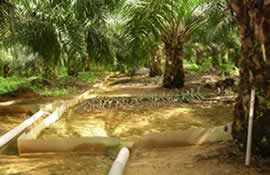
Erosion plots
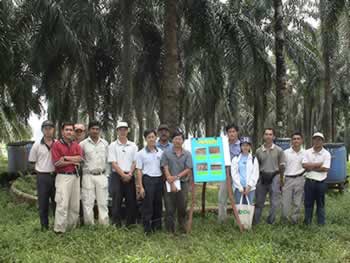
AAR – Felda agronomists beside leaching column
In Malaysia, soil erosion under oil palms on slopes of 4 to 7 was measured at 6 to 13 t ha-1 yr-1 (Maene et al ., 1979; Lim, 1990) compared to jungle area at 0.31 t ha-1 yr-1 (Maene and Sulaiman, 1980). Factors which affect the rate of soil loss are rainfall, rate of run-off, soil types, slope, plant cover and presence or absence of conservation measures.
The main objectives of soil and water conservation are to obtain the maximum sustained level of production from a given area of land by preventing soil degradation and environmental pollution. Therefore, soil conservation practices usually aim at the primary causal factors and areas. For example, reducing or protecting bare areas or exposed soil and reducing the rate of run-off. Timing in implementation of soil conservation measures is also important in plantation tree crops, as the highest risk of erosion usually occurs in specific period such as during planting or replanting and monsoon season.
Soil conservation practices should be considered in the following situations also :
- strongly sloping or rolling areas and steeper (8 or more), particularly where slopes are long,
- highly erodable soils especially in areas with slopes about 6o. Such soils are usually sandy, with weak structure and low in organic matter such as Malau series and Kapilit Family soils,
- areas with poor crop canopies and bare soil or sparse ground cover conditions,
- areas with high and frequent intense rainfalls of more than 25 mm hr-1,
- shallow soils (less than 50 cm) and compacted soils areas.
Lim et al . (1994) suggested that soil and water conservation measures should be implemented on slopes of 30 or more but this has not been adopted by most plantation companies.
The following soil conservation practices should be considered for application in appropriate situations, depending on the specific erosion risks posed in the areas.
Terracing
Generally, there are two kind of terraces, that is, planting terraces and conservation terraces. The former is constructed mainly to facilitate harvesting, crop evacuation and maintenance operation apart from conserving soil and water. Planting terraces should slope inwards and there should be a vertical drop of about 50 cm between the lip and the rear of the terrace to trap run-off water. Regular stops along the terraces are also necessary for the same purpose.
The dimensions of terraces depend on the crops, planting density, slopes and whether future mechanisation will be implemented. In general, the terraces for oil palms should be more than three metre wide and the horizontal distance between two adjoining terraces (6.5 to 9.5 metres) will depend on the planting distance along the terrace and planting density. Similarly for rubber except that the terrace width is generally smaller at 2 metres or more. For cocoa, planting terraces are seldom constructed although it is now highly recommended. The terraces should be 2.5 to 3.5 metre wide with about 12 metres horizontal distance between two adjoining terraces. There is one terrace in every 3rd cocoa row; the other cocoa trees are planted on platforms.
Long slopes which are less than 8 or short rolling to hilly slopes may require conservation terraces instead. They should be cut at approximately 30m intervals, primarily to reduce the length of slope. If platforms are made, they should be about 1.5m x 1.5m for oil palms and 1m x 1m for cocoa.
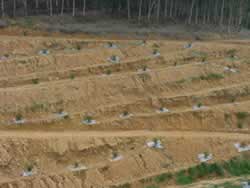
Terracing
Establishment of leguminous cover crops
In cocoa, it is generally not a recommended practice to establish leguminous cover crop. The creeping habit of legumes and high stand of cocoa will make it difficult to maintain. However, other desirable ground vegetation should be kept as discussed in the next section.
In oil palms and cocoa, it is important to establish the legumes to reach full ground coverage as rapidly as possible after land preparation where threats of erosion and land degradation are most real. Ling et al (1979) showed that soil loss on a 10 gradient Munchong series can be 8 folds higher on bare soil compared to legumes or natural covers (Table 3). This is even more important where the effective soil depth is already shallow. Furthermore, Ling et al (1979) reported that soil loss was reduced from 9.0 t ha-1 yr-1 at 0-30% ground coverage to 0.1 t ha-1 yr-1 at 90-100% ground coverage (Table 4). Similar marked reduction in run-off losses were also obtained. Moreover, the other beneficial effects of legumes on soil fertility, soil physical properties and soil biological activities are well-known.
|
Vegetation |
Rainfall (mm) |
Run-off (mm) |
Run-off (% rainfall) |
Soil loss (t ha-1 yr-1) |
|
Bare soil |
1854 |
236 |
15 |
79 |
|
Legumes |
1854 |
70 |
5 |
11 |
|
Natural cover |
1854 |
61 |
3 |
10 |
|
Vegetation |
Ground cover |
|||||
|
0 – 30 % |
90 – 100 % |
|||||
|
Rainfall (mm) |
Run-off (mm) |
Soil loss (t ha-1 yr-1) |
Rainfall (mm) |
Run-off(mm) |
Soil loss (t ha-1 yr-1) |
|
|
Bare soil |
269 |
57 |
13.5 |
287 |
64 |
11.3 |
|
Legumes |
269 |
47 |
9.0 |
287 |
3 |
0.1 |
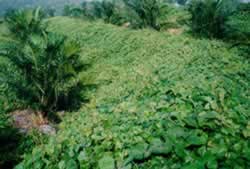
Good legume covers
Maintaining ground vegetation
Table 3 shows that natural covers which are not competitive for nutrients and water can be used to reduce soil erosion and run-off losses. This will improve soil moisture balance compared to bare soil conditions.
Good maintenance of ground covers is especially important in cocoa where legume covers are not established. In the other tree crops, they should be encouraged to gradually succeed the legumes as the latter dieback due to shading effect.
 Good Ground Cover – Nephrolepis |
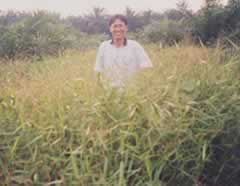 Poor ground cover – thick grasses |
Frond stacking
In mature oil palms there is an additional opportunity to correctly stack the pruned fronds across the slope and cover as much ground area as possible to help in reducing the run-off and erosion losses substantially. This was demonstrated by Maene et al . (1979) on Durian series with mature oil palms on 5 to 9% slopes (Table 5). In terraced areas, pruned fronds placed across the terrace width at regular intervals will also assist to break the flow of run-off water.
| Position in field |
Nutrient loss as % of fertilizer nutrients added |
|||||
|
N |
P |
K |
Mg |
Ca |
B |
|
| Oil palm row |
13.3 |
3.5 |
6.0 |
7.5 |
6.8 |
22.9 |
| Harvest path |
15.6 |
3.4 |
7.3 |
4.5 |
6.2 |
33.8 |
| Pruned frond row |
2.0 |
0.6 |
0.8 |
2.7 |
0.8 |
3.3 |
| Pruned frond/harvest path |
6.6 |
1.4 |
3.5 |
2.2 |
3.4 |
12.5 |
| Average for the field |
11.1 |
2.8 |
5.0 |
5.6 |
5.2 |
20.7 |
| Nutrient from fertiliser applied (kg ha-1) |
90.2 |
52.0 |
205.9 |
32.8 |
78.9 |
2.4 |
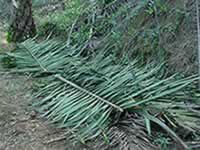
Frond stacking
Mulching with empty fruit bunches (EFB)
Wherever EFB is available, it can be suitably used for mulching especially in new plantings. The mulch will :
- minimise erosion and run-off losses of the bare soil,
- reduce soil moisture evaporation loss during the dry months (Lim and Messchalch, 1979),
- supply nutrients to the planted seedlings,
- improve soil conditions.
Fresh EFB can contain high soluble salts and it is best to keep the EFB until part of the soluble salts are washed or leached off by rain before application to cocoa, which is sensitive to high conductivity.
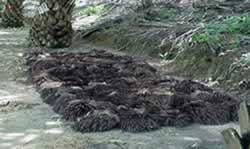
EFB mulching
Silt pits
In some areas, soil erosion and run-off may be very severe even with the construction of soil conservation and planting terraces. For such special areas, the digging of silt pits may be helpful as shown by Lim et al . (1994). However, yield response to silt pitting has not been established.
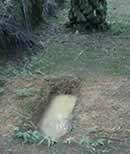
Silt pit
Soil Management: Soil Requirements of Plantation Tree Crops
[addw2p name=”soilMgmtGeneral”]
The first approach in good soil management is to attempt to match the crop requirements with soil properties, with or without amendments. Water and nutrients are probably the most limiting agronomic factors to growth and yield of plantation tree crops (Goh and Chew, 1994). This is because tropical environments usually provide sufficient and uniform sunshine for crop production. It is well known that the above limiting agronomic components are available to plants via the soils. However, to tap into water and nutrients efficiently, the plants need to have good rooting activity.
Rooting activity is influenced by many soil properties such as terrain, soil depths, stoniness, texture, structure, consistence, permeability, drainage and nutrients. These properties generally act in an interactive manner and an understanding of this dynamics is necessary to elevate the yield curve. Therefore correct identification of the types of soil limitations present is vital to soil management.
We also need to assess the severity of the identified soil properties which are limiting yield performances. Overcoming or alleviating them should upgrade the yield performances. It also enables proper formulation and implementation of specific soil management practices in each field in order to maximise return, avoid soil degradation and prevent environmental pollution.
The soil properties and their criteria for assessment of severity of their limitations for plantation tree crops are provided in Appendices 1 to 3 and briefly discussed below.
|
Soil properties |
Desirable range |
Minor limitation |
Serious limitation |
Very serious limitation |
|
Terrain ( ° ) |
0 – 12 |
12 – 16 |
16 – 24 |
> 24 |
|
Effective soil depth (cm) |
> 90 |
60 – 90 |
30 – 60 |
< 30 |
|
Stoniness (%) |
0 – 5 |
5 – 20 |
20 – 40 |
> 40 |
|
Consistence |
friable-moderately firm |
firm |
very firm – loose |
compact |
|
Texture |
sandy clay loam, clay loam or heavier |
loam, sandy loam |
loamy sand |
sand |
|
Structure |
well developed |
moderately developed |
very weak or massive |
structureless |
|
Nutrient status |
low fertiliser requirements |
moderate fertiliser requirements |
high fertiliser requirements |
very high fertiliser requirements |
|
Permeability (drainage) |
Moderately well to well drained |
imperfectly drained |
poorly or excessively drained |
very poorly drained |
|
Water table (depth in cm) |
75 – 90 |
60 – 75 |
30 – 60 |
< 30 |
|
Soil pH |
> 4.0 |
3.5 – 4.0 |
3.0 – 3.5 |
< 3.5 |
|
Conductivity ( mhos/cm) |
< 1000 |
1000 – 1500 |
1500 – 2500 |
> 2500 |
|
Sulphidic layer (depth in cm) |
> 90 |
60 – 90 |
30 – 60 |
< 30 |
|
Peat (depth in cm) |
< 30 |
30 – 100 |
100 – 150 |
> 150 |
|
Soil properties |
Desirable range |
Minor limitation |
Serious limitation |
Vey serious limitation |
|
Terrain ( ° ) |
0 – 6 |
6 – 12 |
12 – 20 |
> 20 |
|
Effective soil depth (cm) |
> 90 |
75 – 90 |
45 – 75 |
< 45 |
|
Stoniness (%) |
0 – 5 |
5 – 20 |
20 – 40 |
> 40 |
|
Consistence |
friable-moderately firm |
Firm |
very firm – loose |
compact |
|
Texture |
sandy clay loam – clay |
loam, sandy loam |
loamy sand |
sand |
|
Structure |
well developed |
moderately developed |
very weak or massive |
structureless |
|
Nutrient status |
low fertiliser requirements |
moderate fertiliser requirements |
high fertiliser requirements |
very high fertiliser requirements |
|
Permeability (drainage) |
Moderately well to well drained |
imperfectly drained |
poorly drained |
very poorly drained |
|
Water table (depth in cm) |
75 – 90 |
60 – 75 |
30 – 60 |
< 30 |
|
Soil pH |
5.5 – 6.5 |
4.5 – 5.5 |
3.5 – 4.5 |
< 3.5 |
|
Conductivity (mhos/cm) |
< 500 |
500 – 1000 |
1000 – 2000 |
> 2000 |
|
Sulphidic layer (depth in cm) |
Unsuitable regardless of depth |
|||
|
Peat (depth in cm) |
Unsuitable regardless of depth |
|||
|
Soil properties |
Desirable range |
Minor limitation |
||
|
Texture |
Sandy clay loam to clay |
Sandy loam, silty clay |
Loamy sand |
Sand |
|
Effective soil depth |
> 100 cm |
60 – 100 cm |
30 – 60 cm |
> 30 cm |
|
Structure |
Strongly developed |
Moderately developed |
Weak or massive |
Very weak or massive |
|
Consistence |
Friable to moderately firm |
Firm |
Very firm |
Very firm |
|
Laterite/gravels |
Nil |
Nil |
25% nodular or fragmented latente 30 cm in thickness |
25% nodular or fragmented latente. > 30 cm in thickness |
|
pH |
4.5 – 5.5 |
4.0 – 4.5 |
3.5 – 4.0 |
> 3.5 |
|
Peat layer |
Nil |
0 – 30 |
30 – 60 cm |
> 60 cm |
|
Permeability |
Moderately well drained to well drained |
Imperfect drainage or very well drained |
poorly drained |
Very poorly drained or excessively drained |
|
Terrain |
0 – 12 |
12 – 23 |
23 – 30 |
> 30 |
|
Nutrient content |
High |
Medium |
Low |
Extremely low or extremely high in trace element |
Terrain
Under Malaysian land law, it is unlawful to cultivate land with slopes more than 20 or 36%. These lands are classified as steepland in Peninsular Malaysia. Such landforms are commonly found in Sarawak and Sabah also and may occur within the plantations. They are usually left unplanted, planted with forestry trees or if the area is small, may be planted with plantation tree crops.
The main problems caused by steep topography are
-
high risks on erosion, landslides and run-off losses of nutrients,
-
poor water balance due to excessive run-off,
-
the need to terrace implies the planting on less fertile sub-soil, which is commonly devoid of organic matter and generally firmer consistence,
-
difficulty in harvesting or tapping and field maintenance operations with probably poorer crop recovery.
Therefore, poor tree performances are not uncommon on steep slopes. However, the effect of slope seems to be less detrimental if the soils are fertile, such as with Kobovan Family soil in Sabah which is derived from basic volcanic parent materials. Rubber and cocoa trees are also less influenced by slopes probably due to easier harvesting operations, tap root system and lower nutrient demand.
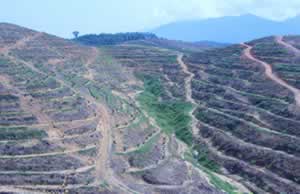
Steep terrain – terraced planting
Soil depth and stoniness
Adequate soil volume is a prime requirement for root development. Soil volume is a function of soil depth and stoniness. In plantation effective soil depth is measured with an Edelman auger to an impenetrable layer within 90 cm depth while increase degree of stoniness will correspond to decrease in rooting space.
The main effects of shallow effective soil volume are :
-
limited root room for adequate amount of roots,
-
weak anchorage,
-
low available soil moisture,
-
low exploitable soil nutrients
In Sabah, stoniness is a less important factor because most rock fragments are loosely formed, partly weathered and mainly only stone sizes and sparse. Therefore, it does not form a continuous barrier to root penetration, development and activity unlike lateritic soils found in West Malaysia.
Under permanent moisture stress conditions as induced by poor rooting volume, cocoa will suffer from drastic wilt and defoliation (Hutcheon et al ., 1973) whereas in oil palms, the inflorescence abortion rate will increase and inflorescence differentiation will tend towards maleness. Lately, work at AAR also confirms that rubber growth and yield will decrease with poorer soil depth.
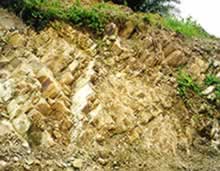
Stoniness – shallow soils
Texture, structure and consistency
These three soil physical parameters are closely related. They determined soil aeration (porosity), water holding capacity, permeability (infiltration), root penetrability and nutrient retention capacity. Unfavourable soil physical conditions inhibit root growth and function, leading to poor plant growth even under liberal applications of fertilisers (Soong and Lau, 1977).
Soil texture can significantly influence our management decisions. For example, in loamy soil to sandy loam soils such as Lintang series, with high percolation and low nutrient and water retention capacity, will need more frequent manuring and mulching to improve crop productivity and reduce environmental pollution. On the other hand, tillage should be avoided on heavy soils such as Briah series to avoid soil compaction which degrades the soils and reduces crop productivity (Cheong and Ng, 1974).
Apart from soils with firm to very firm consistence such as Durian and Batu Anam series soils, soil compaction can be caused by logging activities or use of heavy machineries. The hard pan left behind is difficult to break and establishment of sensitive crops such as cocoa is often unsuccessful.
The permeability of soils to water depends more on the structure with pore spaces than texture itself (Table 1). The implementation of poor permeability on crop growth is discussed in the next section.
|
Soil series |
Infiltration rate (cm hr -1) |
|||
|
0 – 15 cm |
15 – 30 cm |
30 – 45 cm |
45 – 60 cm |
|
|
Sungai Buloh |
115 |
55 |
30 |
23 |
|
Serdang |
26 |
31 |
27 |
15 |
|
Durian |
18 |
0.08 |
0.08 |
0.10 |
Structure also influence soil aerations, which if restricted can cause :
-
inhibited root development
-
impaired respiration of root system leading to reduced water and nutrient absorption
-
inhibited beneficial microbial activities.
Total porosity may differ only slightly between soils of different structure and texture (Table 2) but air-filled porosity (non-capillary pores) is generally better for sandy soils or soils with good structure and friable consistence such as Munchong and Serdang series. Experience indicates that crop growth can be severely limited if air-filled porosity falls to 2% of the total porosity (Soong and Lau, 1977). Soils with good structure are also less erosive and less proned to landslides. The latter is common in Sabah where the soils are generally younger and have weak structures.
| Soil series |
Porosity (%) |
|
|
Total |
Air-filled |
|
| Langkawi |
55 – 58 |
19 – 27 |
| Holyrood |
51 – 53 |
31 – 35 |
| Lunas |
51 – 53 |
24 – 27 |
| Sitiawan |
57 – 59 |
5 – 17 |
| Sogomana |
51 – 55 |
6 – 21 |
| Serdang |
50 – 52 |
24 – 30 |
| Segamat |
61 – 62 |
8 – 16 |
| Malacca |
58 – 60 |
10 – 14 |
| Jerangau |
57 – 58 |
6 – 10 |
| Senai |
58 – 63 |
2 – 19 |
| Harimau |
53 – 55 |
15 – 21 |
| Masai |
55 – 59 |
7 – 13 |
| Rengam |
53 – 56 |
12 – 20 |
| Durian |
63 – 65 |
19 – 27 |
Permeability and drainage
Permeability is generally associated with internal soil drainage and it is closely related to soil physical properties as mentioned earlier. Poor permeability can cause
-
perched water table such as in podzols
-
imperfect drainage even in hilly soils such as Batu Anam series,
-
poor rooting activity and its consequences as described earlier.
On flood plains and valley floors, high water table can be a common feature as in most Gleysols or Aquepts. Excessively high water table can give rise to :
-
inadequate soil aeration which hampers root respiration and causes poor nutrient and water uptake,
-
poor anchorage and lodging due to poor root development,
-
canopies turn chlorotic resulting in poor photosynthesis
Generally, oil palm is less influenced by poor permeability and drainage compared to cocoa and rubber.
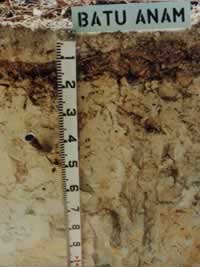 Poor permeablility |
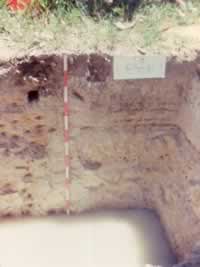 Poor drainage |
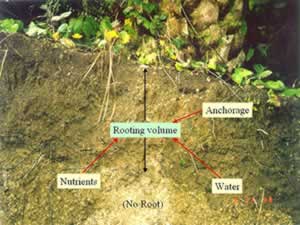
Root anchorage
Nutrient status
Malaysian soils have highly heterogenous inherent soil nutrient status (Goh et al , 1993). For example, Selangor series soils and young soil derived from basic volcanic rocks tend to have high soil fertility compared to sandy or highly weathered soils such as Munchong series. Moreover, soils in Sabah generally have high Mg content compared to West Malaysian soils (Goh et al , 1993).
Nutrients, being one of the two most limiting factors to crop productivity, must be correctly assessed to afford proper fertiliser management practices. Over- or under-application of fertilisers can have disastrous effects such as
-
poor crop productivity due to lack of fertiliser or imbalance,
-
less in profit due to excess fertilisation,
-
soil acidification and degradation,
-
environmental pollution due to excessive leaching and run-off losses.
Apart from acid sulphate soils, serious to very serious limitations on soil pH do not occur for oil palms and rubber. However, cocoa trees are more sensitive to soil acidity and liming to raise pH above 4.5 or exchangeable Al saturation less than 30% is usually necessary for optimum production.
Other soil limitations
The other soil limitations are generally associated with particular type of soils. These limitations are high salinity or conductivity in saline soils (Bakau series), sulphidic layer in acid sulphate soil and peat. These will be discussed in detail in part two of this lecture note and in tomorrow lecture on problem soils.
Soil management requirements for plantation tree crops
After going through the soil properties and their limitations, we can broadly summarise the major soil management requirements into:
-
soil and water conservation management,
-
soil fertility management,
-
soil acidity management,
-
soil water management,
as described by Cheong and Goh (1988). Soil and water conservation management also includes the amelioration and improvement of soil physical properties.
